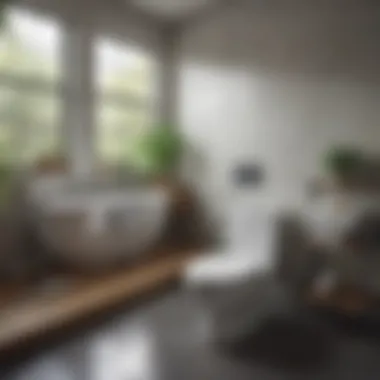Effective Strategies for Unclogging a Toilet


Intro
Accurate knowledge about the correct tools and methods to use can save time, money, and frustration. So, understanding best practices is vital, especially for DIY enthusiasts and homeowners. With that in mind, let's transition into the specific strategies available to effectively manage toilet clogs.
Understanding Toilet Clogs
Understanding the underlying mechanics of toilet clogs is crucial for any homeowner. Clogs can lead to frustrating plumbing issues that disrupt daily life, not to mention potential damage to plumbing systems and increased repair costs. Knowing what causes clogs and how to identify them early allows for timely intervention. This proactive approach can often save a lot of trouble.
Common Causes of Clogs
Numerous factors contribute to toilet clogs. The most frequent causes include:
- Excessive toilet paper: Many people underestimate how much toilet paper they use. Flushing large amounts at once can lead to blockages.
- Foreign objects: Items not intended for toilets, such as toys, feminine hygiene products, and wipes, can easily become stuck and create problems. It’s essential to educate family members about proper toilet use to prevent these issues.
- Flushing too much at once: Sometimes, simply flushing more than necessary can overwhelm the plumbing system, leading to a clog.
- Old plumbing systems: Older pipes may not handle modern waste as effectively. They can accumulate buildup over time, making clogs more likely.
- Tree roots: In some cases, invasive tree roots can penetrate sewer lines, causing severe obstructions.
Understanding these common causes helps in addressing the issue before it escalates. Awareness can lead to better usage practices that significantly reduce the chance of recurring clogs.
Signs of a Clogged Toilet
Identifying the signs of a clogged toilet early can prevent more significant problems later on. Key indicators include:
- Slow flushing: If your toilet takes more time to flush than usual, this might indicate a developing clog.
- Water level fluctuations: If the water level in the toilet bowl rises after flushing and then slowly drains away, this is another warning sign.
- Unusual sounds: Gurgling sounds from the toilet or nearby pipes could signal that wastewater is struggling to pass through the pipes.
- Backflow: Seeing water or waste return to the bowl indicates a significant clog that may need immediate attention.
By recognizing these signs, homeowners can act quickly to resolve the issue before it worsens. Prompt action can often resolve small issues before they become costly repairs.
DIY Techniques for Unclogging Toilets
When faced with a clogged toilet, initiating a do-it-yourself approach can save time and money. DIY techniques empower homeowners with practical skills to address common plumbing issues efficiently. Engaging in these methods not only enhances your home maintenance knowledge but also reduces reliance on professionals for minor issues.
Utilizing DIY strategies allows individuals to become more familiar with their home plumbing system, which can help prevent future clogs. Here, we will explore several effective DIY methods that anyone can execute with minimal tools and supplies.
Using a Plunger
The plunger is perhaps the most recognized tool for tackling clogged toilets. Its design is simple but effective. To use a plunger:
- Select the Right Type: Ensure you have a flange plunger, which is specifically designed for toilets.
- Create a Seal: Insert the plunger into the toilet bowl and press down to create a tight seal.
- Plunge Effectively: Push down and pull up rapidly, maintaining the seal. Repeat this motion several times for effective results.
- Flush: After several plunges, try flushing the toilet to see if the clog has cleared.
This method is often successful because the force generated by the plunger can dislodge obstructions in the pipes.
Employing a Toilet Auger
For stubborn clogs that resist the plunger, a toilet auger can be more effective. This long, flexible tool is designed to break up and dislodge debris that may be lodged in the toilet trap. When using a toilet auger:
- Insert the Auger: Carefully guide the auger into the toilet bowl until it meets resistance.
- Crank the Handle: Turn the handle to extend the auger further into the trap, breaking apart the clog.
- Retract and Clean: Once you believe the obstruction is cleared, slowly retract the auger, which may pull out additional debris.
- Flush: Finally, flush the toilet to confirm that the clog has been successfully cleared.


This method requires some technique but often yields excellent results for tougher blockages.
Hot Water Method
Using hot water is a surprisingly effective approach for certain types of clogs, particularly those caused by organic materials or soap buildup. To utilize hot water:
- Boil Water: Heat a pot of water until it is very hot but not boiling.
- Pour Carefully: From waist height, pour the hot water directly into the toilet bowl. The force of the water can help to break up the clog.
- Wait and Observe: Allow a few minutes for the hot water to work on the obstruction.
- Attempt to Flush: After waiting, try flushing the toilet to see if the clog has cleared.
This method is safe and often effective, provided the toilet and its plumbing are in good condition.
Baking Soda and Vinegar Approach
Another eco-friendly method involves using common household items: baking soda and vinegar. This combination creates a natural reaction that can help break down clogs. Here’s how to execute this method:
- Pour Baking Soda: Start by adding one cup of baking soda directly into the toilet bowl.
- Add Vinegar: Follow with two cups of vinegar. You will see fizzing and bubbling.
- Let it Sit: Allow this mixture to sit for 20-30 minutes to break down whatever is causing the clog.
- Flush: After waiting, flush the toilet to ascertain if the clog has cleared.
This method is simple and utilizes safe ingredients, making it an excellent choice for those concerned about chemical cleaners.
Commercial Products for Unclogging Toilets
When enduring a clogged toilet, many homeowners turn to commercial products as a swift solution. Understanding the realm of these products equips individuals with the knowledge to make informed choices. Such items often provide effective, immediate relief from clogs that adhere to common household usage patterns. Furthermore, these solutions come with their own set of advantages and caveats.
The use of commercial cleaning products can save time. Often, they are designed for quick action, working to dissolve blockages effectively. However, concerns about safety, environmental impact, and potential harm to plumbing systems become pertinent. It's crucial to evaluate both the effectiveness and repercussions of these commercial offerings.
Liquid Drain Cleaners
Liquid drain cleaners are among the most common aids for quickly alleviating toilet clogs. These powerful formulas are designed to break down waste materials and clear blockages. They typically contain potent chemicals that provide immediate assistance. Nonetheless, safety considerations must be taken.
- Always ensure proper ventilation when using these cleaners.
- Follow manufacturer instructions precisely to minimize risks.
Potential Risks:
- Harsh chemicals can be harmful to the environment and may cause damage to pipes if misused.
- Repeated use could lead to corrosion within the plumbing system over time.
It's vital to weigh the urgency of the situation against the possible long-term effects on your plumbing and health.
Enzymatic Drain Cleaners
Enzymatic drain cleaners offer a biological approach to unclogging toilets. They rely on enzymes to break down organic waste materials. This method has gained popularity due to its eco-friendly characteristics and lower risk of plumbing damage.
Advantages of enzymatic cleaners include:
- Safe for most plumbing types
- Environmentally friendly option
- Effective for maintaining clear pipes when used regularly


However, enzymatic solutions may not work as quickly as traditional chemical cleaners, requiring regular use for optimal results.
Professional-Grade Solutions
In more severe clogging scenarios, professional-grade solutions may be necessary. These products tend to be stronger than typical retail offerings, designed for serious blockages. Available to both consumers and professionals, these solutions often contain higher concentrations of chemicals, thus offering powerful unclogging capabilities.
- These products can tackle more stubborn clogs created by grease, hair, or other dense obstructions.
- Proper application and precautions remain essential to avoid damage and ensure safety.
Environmental Considerations
In the context of unclogging toilets, environmental considerations have gained prominence as awareness about sustainability and eco-friendliness increases. Homeowners are now more concerned with the impact of the methods and products they use on the environment. Using traditional chemical cleaners often poses risks not just to plumbing systems, but also to the wider ecosystem. When these chemicals enter the water supply, they can contribute to pollution and harm aquatic life.
The significance of evaluating environmental considerations lies in the balance between effective unclogging solutions and the harmful effects these solutions might have. It is important to seek techniques that not only clear the blockages effectively but also mitigate adverse environmental effects. By being proactive, homeowners can utilize methods and products that are safe and sustainable, contributing to a healthier living environment.
Eco-Friendly Alternatives
Several eco-friendly alternatives exist that can effectively unclog toilets without introducing harmful substances into the environment. Here are some options:
- Baking Soda and Vinegar: This classic combination can dissolve minor clogs. The reaction between baking soda and vinegar generates fizzing action that can help break down the obstruction.
- Hot Water: Pouring hot water down the toilet can loosen clogs by softening solidified waste or toilet paper. Ensure the water is not boiling to avoid damaging porcelain.
- Salt and Baking Soda: Mixing salt with baking soda can enhance the unclogging effect. This mix can be effective for breaking down waste accumulation.
Utilizing these eco-friendly options promotes sustainability while effectively addressing toilet clogs.
Impact of Chemical Cleaners
Chemical drain cleaners are often marketed as quick solutions for unclogged toilets. However, their use can have far-reaching negative impacts.
- Plumbing Damage: these strong chemicals can corrode pipes over time, leading to expensive repairs.
- Environmental Harm: Once these chemicals flush through the plumbing system, they reach wastewater treatment plants, where they can impact the treatment processes and be released back into waterways, harming ecosystems.
- Human Health Risks: Many chemical cleaners release toxic fumes. This can pose health hazards, particularly in poorly ventilated spaces.
"Using chemical drain cleaners can solve a problem in the short term but at a cost that may not be obvious until later."
In summary, weighing the impacts of chemical cleaners against their convenience can steer homeowners towards more sustainable practices. Choosing eco-friendly alternatives not only unclogs toilets but also preserves the integrity of plumbing systems and protects the environment.
Preventive Measures to Avoid Clogs
Preventing toilet clogs is essential for maintaining a functional bathroom and avoiding the stress of an immediate plumbing issue. Implementing effective preventive measures can not only enhance the longevity of your plumbing but also save you time and money in the long run. It is crucial to understand the habits and practices that can significantly reduce the occurrence of clogs. This section focuses on practical strategies that contribute to a smoother toilet operation.
Proper Toilet Usage
Understanding how to use the toilet correctly is a fundamental aspect of preventing clogs. Ensuring appropriate item disposal is key. Here are several points to consider about proper toilet usage:
- Flush Only Human Waste and Toilet Paper: Other materials like feminine hygiene products, wipes, or paper towels should never be flushed. These items do not break down properly and can easily cause blockages.
- Limit the Amount of Toilet Paper: While it is acceptable to use toilet paper for hygiene, excessive use can lead to clogs. Opt for necessary amounts instead of an excessive pile.
- Educate Family Members: Ensure that all users, including children, understand what can and cannot be flushed. This knowledge is foundational for maintaining toilet health.
Learning and practicing these habits can reduce the chances of a clog in many cases.


Regular Maintenance Tips
Regular maintenance is an instrumental part of ensuring that your toilet remains clog-free. Here are some tips to facilitate this process:
- Routine Inspection: Periodically check for signs of blockage. Catching a problem early can prevent a larger issue from developing. Look for slow drainage or unusual noises.
- Avoid Chemical Cleaners: While they may seem convenient, frequent use of harsh chemical cleaners can damage plumbing. Opt for softer methods such as vinegar or baking soda, which can effectively remove buildup without causing harm.
- Create a Cleaning Schedule: Develop a routine for cleaning your toilet to ensure that buildup does not have a chance to accumulate. Using natural solutions can keep the toilet fresh without creating risks for future clogs.
Regular maintenance and correct usage are essential to prolonging the life of your toilet and plumbing system.
Incorporating these preventive measures can significantly decrease the likelihood of clogs while promoting sound toilet habits. This proactive approach not only saves inconvenience but also enhances overall home plumbing satisfaction.
When to Call a Professional
Homeowners often find themselves faced with toilet clogs. While many situations can be addressed with DIY methods, certain indicators may arise that compel you to seek professional help. Recognizing when a simple issue has escalated into a more complicated problem is essential. Calling a plumber can save time, money, and frustration.
Indicators of a Serious Issue
It is crucial to identify signals that suggest a problem may be beyond your skill level. Here are some common indicators:
- Persistent Clogs: If your toilet continues to clog despite multiple attempts to fix it, this might reflect a deeper issue in the plumbing system.
- Multiple Fixtures Affected: A blockage in one toilet is manageable. However, when other fixtures, like sinks or bathtubs, also back up, it may indicate a main drain line issue.
- Unpleasant Odors: Unexplained sewer or gas-like smells could suggest that waste is trapped somewhere in your plumbing, needing expert intervention.
- Frequent Overflowing: If overflows happen regularly, this is not just inconvenient; it can cause water damage and dissatisfaction.
When any of these signs arise, it is advisable to consult a plumbing professional. Their expertise can ensure that the underlying problems are diagnosed correctly and fixed safely.
Cost Considerations
Deciding to hire a professional comes with financial implications. Costs can vary broadly depending on several factors, including:
- Location: Prices may differ greatly based on the regional service rates.
- Severity of the Issue: Minor repairs will naturally cost less than extensive work like snaking the main line or replacing parts.
- Time: The longer the job takes, the higher the total bill. Quick fixes will usually be more economical.
- Materials Used: If new parts or specialized tools are needed, this will obviously increase the costs.
Having a rough idea about these factors can help you prepare financially when facing a serious plumbing issue.
"Prompt action can often prevent minor issues from escalating into extensive damage."
Ensuring the longevity and functionality of your plumbing system is not just about addressing immediate issues, but also about maintaining a proactive approach to home maintenance.
Finale
Understanding how to effectively unclog a toilet is essential for every homeowner. The methods discussed throughout this article show that there are numerous strategies to deal with this common household nuisance. From straightforward DIY techniques to professional solutions, each approach has its own benefits.
Summarizing Effective Strategies
We have explored various methods:
- Using a Plunger: This fundamental tool should be the first line of defense. It creates pressure that can dislodge clogs effectively.
- Employing a Toilet Auger: A toilet auger is useful for deeper clogs and is less likely to damage plumbing.
- Hot Water Method: Simple but effective, pouring hot water can soften blockages caused by toilet paper or organic waste.
- Baking Soda and Vinegar Approach: Known for its chemical reaction, this method can help break down lighter clogs without harsh chemicals.
- Commercial Products: These include liquid and enzymatic drain cleaners, which serve specific types of clogs but should be used with caution due to environmental concerns.
Each of these strategies can aid in preventing further complications in plumbing, allowing for swift resolutions. Regularly utilizing these approaches ensures that minor issues do not escalate into major repairs, ultimately saving time and money.
The Importance of Proactive Maintenance
Taking preventive measures is vital. Establishing a routine for checking and maintaining your toilet can materially reduce the likelihood of clogs. Proper usage, such as not flushing non-flushable items, plays a critical role. Additionally, regular inspections and maintenance of the plumbing system can catch potential issues before they manifest as clogs.
By prioritizing proactive maintenance, homeowners can ensure their plumbing systems function efficiently. Minimizing clogs promotes better hygiene and less stress regarding home upkeep. Thus, understanding these elements not only helps in the immediate sense but also contributes toward long-term plumbing health.



